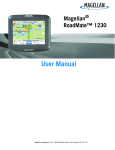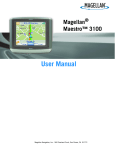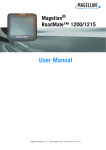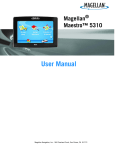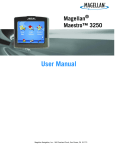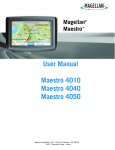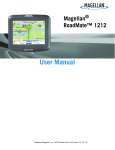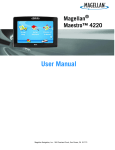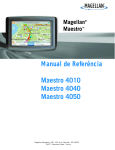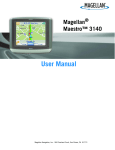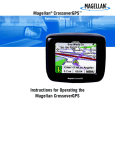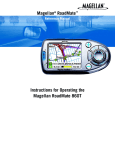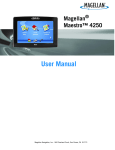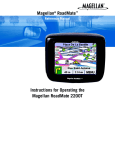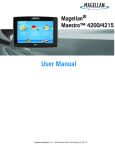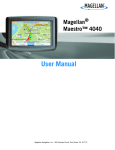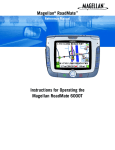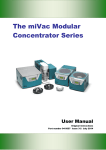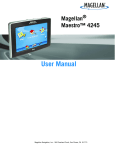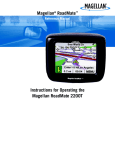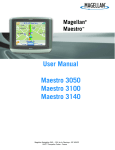Download Lyngdorf Audio BW-1 Speaker User Manual
Transcript
Magellan® RoadMate™ Models 1400 / 1415 / 1425 User Manual Magellan Navigation, Inc. 960 Overland Court, San Dimas, CA 91773 IMPORTANT SAFETY WARNINGS The Magellan RoadMate is a vehicle-navigation aid designed to assist you in arriving to your selected destinations. When using the Magellan RoadMate, these safety rules must be followed to prevent accidents that can result in injury or death to yourself or others: • • • • • • When driving, the need to view the display is minimal. The driver should enter data or program the Magellan RoadMate only when the vehicle is stopped. Only a vehicle passenger should enter data or program the Magellan RoadMate while the vehicle is moving. It is your responsibility to comply with all traffic laws. Every attempt is made to ensure that the database is accurate. However, roadways, points of interest (POIs), and business and service locations may change over time. The database does not include, analyze, process, consider, or reflect any of the following: legal restrictions (such as vehicular type, weight, height, width, load and speed restrictions); road slope or grade; bridge height, width, weight, or other limits; population density; neighborhood quality or safety; availability or proximity of law enforcement, emergency rescue, medical, or other assistance; construction work zones or hazards; road or lane closures; road, traffic, or traffic facilities’ safety or condition; weather conditions; pavement characteristics or conditions; special events; traffic congestion. It is your responsibility to disregard any unsafe, hazardous, or illegal route suggestions. Keep the Magellan RoadMate safe from extreme temperature conditions. For example, do not leave it exposed to direct sunlight for an extended period of time. Take care when mounting the Magellan RoadMate in your vehicle, whether using the windshield mount or other mounting accessories, that it does not obstruct the driver's view of the road, interfere with the operation of the vehicle's safety devices such as air bags, or present a hazard to occupants of the vehicle should the Magellan RoadMate be dislodged while driving. You assume the risks associated with damage to your vehicle or vehicle occupants as the result of your choices in mounting the Magellan RoadMate. The battery in the Magellan RoadMate is rechargeable and should not be removed. In the event it should need to be replaced, please contact Magellan Technical Support. About Charging the Magellan RoadMate • • • • An optional AC adapter is available as an accessory for your Magellan RoadMate. Use of another type of AC adapter can result in malfunction and/or possible fire hazard due to battery over heating. Use only the vehicle power cable approved for / supplied with your Magellan RoadMate. Use of another type of vehicle power cable will result in malfunction and/or damage to the receiver. For safety reasons, the battery in your Magellan RoadMate will stop charging when the ambient temperature is less than 32°F (0°C) or more than 113°F (45°C). It will take approximately 6 hours of charging the Magellan RoadMate through the vehicle power adapter or optional AC adapter to obtain a full battery charge. About the Battery • • Do not attempt to replace the battery. Please contact Magellan Technical Support for issues related to the battery. Use only the charger approved for your Magellan RoadMate. i IMPORTANT SAFETY WARNINGS Federal Communication Commission Interference Statement This equipment has been tested and found to comply with the limits for a Class B digital device, pursuant to Part 15 of the FCC Rules. These limits are designed to provide reasonable protection against harmful interference in a residential installation. This equipment generates, uses and can radiate radio frequency energy and, if not installed and used in accordance with the instructions, may cause harmful interference to radio communications. However, there is no guarantee that interference will not occur in a particular installation. If this equipment does cause harmful interference to radio or television reception, which can be determined by turning the equipment off and on, the user is encouraged to try to correct the interference by one of the following measures: • • • • -Reorient or relocate the receiving antenna. -Increase the separation between the equipment and receiver. -Connect the equipment into an outlet on a circuit different from that to which the receiver is connected. -Consult the dealer or an experienced radio/TV technician for help. This device complies with Part 15 of the FCC Rules. Operation is subject to the following two conditions: (1) This device may not cause harmful interference, and (2) this device must accept any interference received, including interference that may cause undesired operation. FCC Caution: Any changes or modifications not expressly approved by the party responsible for compliance could void the user's authority to operate this equipment. IMPORTANT NOTE: FCC Radiation Exposure Statement: This equipment complies with FCC radiation exposure limits set forth for an uncontrolled environment. End users must follow the specific operating instructions for satisfying RF exposure compliance. This transmitter must not be co-located or operating in conjunction with any other antenna or transmitter. In order to maintain compliance with FCC regulations, shielded cables must be used with this equipment. Operation with non-approved equipment or unshielded cables is likely to result in interference to radio and TV reception. The user is cautioned that changes and modifications made to the equipment without the approval of manufacturer could void the user's authority to operate this equipment. The Magellan RoadMate must be installed and operated at a distance no closer then 8 inches (20 cm) from the user. This Class B digital apparatus meets all requirements of the Canadian Interference-Causing Equipment Regulations. Cet appareil numerique de la classe B respecte toutes les exigences du Reglement sur le materiel brouilleur du Canada. ii IMPORTANT SAFETY WARNINGS IC statement Operation is subject to the following two conditions: 1. 2. This device may not cause interference and This device must accept any interference, including interference that may cause undesired operation of the device. IMPORTANT NOTE: IC Radiation Exposure Statement: This equipment complies with IC radiation exposure limits set forth for an uncontrolled environment. End users must follow the specific operating instructions for satisfying RF exposure compliance. This transmitter must not be co-located or operating in conjunction with any other antenna or transmitter. The information provided in this document is subject to change without notice. Improvements and enhancements to the product may occur without any formal notification. Check the Magellan website (www.magellanGPS) for product updates and additional information. © 2008 Magellan Navigation, Inc. All rights reserved. The Magellan Logo, Magellan, Magellan RoadMate, TrueView, SmartDetour, and SmartVolume are trademarks of Magellan Navigation, Inc. No part of this user manual may be reproduced or transmitted in any form or by any means, electronic or mechanical, including photocopying and recording, for any purpose other than the purchaser’s personal use, without the prior written permission of Magellan Navigation, Inc. 604-0146-002 A iii Table of Contents Table of Contents ....................................................................................................................1 Magellan RoadMate ................................................................................................................1 Magellan RoadMate ................................................................................................ 2 Installation Instructions ...........................................................................................................3 Selecting the Location ............................................................................................ 3 Cleaning the Area ................................................................................................... 3 Attach the Cradle to the Swivel Mount ...................................................................... 3 Secure the Swivel Mount to the Windshield .............................................................. 3 Attaching the Magellan RoadMate to the Cradle ........................................................ 3 Adjust the Mount for Optimum Viewing .................................................................... 4 Connecting Power .................................................................................................. 4 Check Connection and Final Adjustments ................................................................. 4 Security ................................................................................................................ 4 Country Selection ................................................................................................... 5 Fundamentals ..........................................................................................................................6 Powering on the Magellan RoadMate ........................................................................ 6 Turning the Magellan RoadMate On ..................................................................... 6 Turning the Magellan RoadMate Off .................................................................... 6 Selecting Auto-Power Shutdown Time .................................................................. 6 Volume .................................................................................................................. 6 Changing the Volume from the Map Screen. ......................................................... 6 Changing the Volume from User Options .............................................................. 7 Brightness ............................................................................................................. 7 Accessing the Brightness Control ........................................................................ 7 The Main Menu ...................................................................................................... 7 Accessing the Main Menu ................................................................................... 7 .Main Menu - Page 1 ......................................................................................................8 .Main Menu - Page 2 ......................................................................................................9 The Keypad ......................................................................................................... 10 Keypad Overview ..........................................................................................................10 Special Keys ................................................................................................... 10 Selecting From List ....................................................................................................... 10 Notes on Entering Data .................................................................................................11 Map Screen ..........................................................................................................................12 Accessing the Map Screen ................................................................................ 14 Table of Contents Magellan RoadMate 1 2D Mode ......................................................................................................................14 Setting the Map Modes (2D or 3D) .................................................................... 14 Panning on the Map ......................................................................................... 14 Saving a Position While Panning ....................................................................... 14 Routing to a Panned Position ............................................................................ 15 Current Location Screen ....................................................................................... 15 Accessing the Current Location Screen .............................................................. 15 Saving Your Current Location to Your Address Book ............................................ 15 Maneuver List Screen ........................................................................................... 16 Accessing the Maneuver List ............................................................................. 16 Excluding a Maneuver ...................................................................................... 16 GPS Status Screen ............................................................................................... 16 Accessing the GPS Status Screen ..................................................................... 16 Zoom Levels ........................................................................................................ 16 Setting Zoom Levels ........................................................................................ 17 Volume ................................................................................................................ 17 Changing the Volume from the Map Screen. ....................................................... 17 Home Address ....................................................................................................................... 18 Creating a Home Address ................................................................................. 18 Creating a Route to the Home Address ............................................................... 18 Changing the Home Address ............................................................................. 18 Accessing the Home Address from the Address Book .......................................... 19 Enter Address ........................................................................................................................20 Entering an Address ............................................................................................. 20 Creating a Route to a New Address .................................................................... 20 My Addresses ....................................................................................................... 21 Accessing the My Addresses Menu .................................................................... 21 Previous Destinations ...................................................................................................21 Routing to a Previous Destination (Method 1) ..................................................... 21 Routing to a Previous Destination (Method 2) ..................................................... 21 Saving a Previous Destination to Your Address Book ............................................ 21 Deleting a Previous Destination ......................................................................... 22 Address Book ...............................................................................................................22 Accessing an Address in Your Address Book ....................................................... 22 Routing to an Address in Your Address Book ...................................................... 22 Editing an Address in Your Address Book. .......................................................... 23 Deleting an Address in Your Address Book. ........................................................ 23 Favorites ......................................................................................................................23 Table of Contents Magellan RoadMate 2 Accessing an Address from Favorites ................................................................. 23 Routing to an Address from Your Favorites List ................................................... 23 Editing an Address from Your Favorites List ....................................................... 23 Deleting an Address from Your Favorites List ...................................................... 24 Creating a New Entry .................................................................................................... 24 Creating a New Entry to You Address Book by Selecting on the Map ..................... 24 Creating a New Entry to You Address Book by Entering an Address ....................... 24 Creating a New Entry to You Address Book from a POI ........................................ 25 Points of Interest (POI) ..........................................................................................................26 Categories and Subcategories ................................................................................ 26 Creating a Route to a POI by Category ............................................................... 26 Creating a Route to a POI by Name ................................................................... 27 My POIs .............................................................................................................. 27 Loading a POI File ........................................................................................... 27 Selecting Categories for Display on the Map ....................................................... 28 Setting Alarms ................................................................................................ 28 Setting Alarm Parameters ................................................................................. 28 Routing to a Loaded POI .................................................................................. 29 Saving a Loaded to Your Address Book .............................................................. 29 Marco Polo (Magellan RoadMate 1425 Only) .......................................................... 29 Travelling on a Route ............................................................................................................30 Map Screen ......................................................................................................... 30 Split-Screen .................................................................................................................. 30 Maneuver List ...............................................................................................................30 You Have Arrived ..........................................................................................................31 Types of Routes ................................................................................................... 31 Route Method ...................................................................................................... 31 Special Routing Functions .................................................................................... 32 Routing to a POI Near an Approaching Freeway Exit ............................................ 32 Cancelling a Route .......................................................................................... 32 Detouring off a Route ....................................................................................... 32 Changing the Route Method ............................................................................. 33 Traffic (Magellan RoadMate 1425 only) ................................................................................. 34 Glossary .............................................................................................................. 34 Understanding How The TrafficKit Works ................................................................ 34 RDS-Traffic Operating Modes .......................................................................................34 Selecting Categories of Traffic Events ............................................................................35 Table of Contents Magellan RoadMate 3 Re-routing Mode ..........................................................................................................35 Traveling with the Re-routing Mode On ................................................................... 36 Alert Only Mode ............................................................................................................36 Traveling with the Alert Mode On .................................................................................. 37 Traffic Alert Icon ................................................................................................. 37 Viewing Traffic Details ...................................................................................................37 Viewing Traffic Details at Higher Zoom Levels ................................................................37 Disabling the RDS ........................................................................................................38 FAQs ................................................................................................................... 38 Trip Planner ..........................................................................................................................39 Creating a Trip ................................................................................................ 39 Optimizing a Trip ............................................................................................. 40 Starting a Trip ................................................................................................. 40 Editing a Trip .................................................................................................. 41 Deleting a Trip ................................................................................................ 41 Renaming a Trip .............................................................................................. 41 Exit POIs ...............................................................................................................................42 Routing to a POI Near an Approaching Freeway Exit ............................................ 42 User Options ......................................................................................................................... 43 Selecting Map Region ...................................................................................... 43 Accessing System Settings ............................................................................... 43 Checking Battery Life ....................................................................................... 43 Adjusting the Volume ....................................................................................... 43 Adjusting the Display Brightness ....................................................................... 44 Setting Auto Power Off Time ............................................................................. 44 Setting Time Zone ........................................................................................... 44 Selecting Units of Measure ............................................................................... 44 Displaying Contact Us Information .................................................................... 45 Displaying Product Information ......................................................................... 45 Performing Diagnostics .................................................................................... 45 Accessing the Trip Computer ............................................................................ 45 Selecting POIs to be Displayed on the Map ........................................................ 46 Deleting Addresses from the Address Book (Global) ............................................ 46 Speed Trap Settings ........................................................................................ 47 Updating Speed Trap Databases ....................................................................... 47 Setting the Map in 3D or 2D Mode .................................................................... 47 Setting the Map Display to Heading Up or North Up ........................................... 47 Setting Split Screen (TrueView™) Options ......................................................... 48 Table of Contents Magellan RoadMate 4 Setting Auto Night Map Display ........................................................................ 48 Setting Detour Options ..................................................................................... 49 Using the Simulator ......................................................................................... 49 Setting Tone Options ....................................................................................... 50 Setting Voice Alerts (Text-to-Speech) [Magellan RoadMate 1415 and 1425 only] . 50 Viewing Technical GPS Information ................................................................... 50 Setting the GPS Position .................................................................................. 50 Backing Up and Restoring Data ........................................................................ 51 Backing Up Data ............................................................................................. 51 Restoring Data ................................................................................................ 51 Viewing Map Information .................................................................................. 51 Table of Contents Magellan RoadMate 5 Magellan RoadMate The Magellan RoadMate is a vehicle navigation product that utilizes GPS signals from satellites to calculate your precise location and compute details about its travel. Knowing its position and movement, it can then overlay this information on detailed maps to provide a visual representation of your location. Be sure to check the support page at www.magellanGPS.com/support/ for updates to your Magellan RoadMate. While you are there, download the Magellan VantagePoint software which can be used to install the updates quickly and easily. Another useful tool for your Magellan RoadMate is the Magellan POI Editor, also available at www.magellanGPS.com/support/. With the Magellan POI Editor you can add custom POIs to your Magellan RoadMate. Just follow the easy instructions to install the POI Editor. With the Magellan RoadMate you can: • Store your home address and quickly get routing details to your home. • Create and save addresses in your address book that can be accessed at any time and get routing information to that address. • Route to an address that you enter using the keypad and Magellan’s QuickSpell feature for easy, errorless address entry. • Route to any point of interest (POI) that has been preloaded into your Magellan RoadMate. • Route to a POI that appears on the map while traveling simply by tapping on the POI icon. • Create a trip with multiple destinations using the trip planner. Handy for business people who need routing information to many destinations. • View POIs that are ahead of you on the freeway. The exit POI function provides you with a list of petrol stations, restaurants, hotels and auto repair shops located nearby exits you are approaching while traveling on a freeway. • Customize your Magellan RoadMate to meet your needs using the User Options menu. • With the Magellan RoadMate 1425 you can view traffic information so as to avoid delays in your travel. The interface for the Magellan RoadMate is easy and simple to follow once you understand the basics. You may never need to refer to this manual but if you do we have tried to present it in a form that you can access the function you are trying to complete and follow the steps provided. The Magellan RoadMate has a built-in battery so in most cases you will be able to follow these instructions while reading them on your computer screen without plugging the Magellan RoadMate to AC power. You should note that while indoors you may not get any satellite signals so your location information would not be updated. However, the Centrality™ chipset installed in the Magellan RoadMate will get satellite signals in some very rough locations so you may notice the Magellan RoadMate computing a position, even indoors. Differences between the Magellan RoadMate 1400, Magellan RoadMate 1415 and the Magellan RoadMate 1425. All receivers store the maps on the SD card that has been preloaded at the factory. The map on the Magellan RoadMate 1400 is only for the region purchased, whereas the Magellan RoadMate 1415 and the 1425 have larger SD cards containing the available European regions. With the Magellan RoadMate 1415 and 1425, you can access any of the available European countries by using the Region function of User Options. The Magellan RoadMate 1400 has a Country Selection function, but only for those countries installed on the SD card. Magellan RoadMate 1 The Magellan RoadMate 1415 and the Magellan RoadMate 1425 both include Voice Alerts (Text to Speech) for maneuver instructions. (Available only in English, French, German, Spanish and Italian. The Magellan RoadMate 1425 additionally has integrated traffic capabilities as well access to additional POIs provided by MarcoPolo. This document is set up to be printed on A4 paper should you desire a printed version for your reference. Magellan RoadMate A B C D E A Power Button B Reset Button C Traffic Antenna Connector (Magellan RoadMate 1425 only) D USB connector. Power input from vehicle power adapter cable or AC power adapter (+5 VDC / 2A). E SD Card slot Magellan RoadMate 2 Installation Instructions Installation of the Magellan RoadMate is simple and easy. The hardest part will be picking the best location. Selecting the Location A few tips on selecting the proper location. • Mount the Magellan RoadMate in a place where it can be easily seen and will not interfere with your view of the road. • The Magellan RoadMate should be mounted in such a way that the antenna, (located in the top of the receiver), has an unobstructed view of the sky through the windshield. • Make sure that the Magellan RoadMate nor any cabling will be disturbed in the event that the airbags are deployed. Cleaning the Area Use the alcohol pad that came with the Magellan RoadMate to clean the area on the windshield that has been selected for mounting the Magellan RoadMate. Let the area dry completely. Attach the Cradle to the Swivel Mount Line up the two tabs on the swivel mount with the holes on the back of the cradle. Push the cradle down until it locks in place with the swivel mount. Secure the Swivel Mount to the Windshield Make sure that the lever at the base of the adjustable mount is in the up position. Place the base of the swivel mount firmly over the area of the windshield to be used. Push the lever at the base of the swivel mount all the way down until it snaps in place. Carefully let go of the assembly, making sure that it is securely mounted. Please note that the swivel mount supplied with the Magellan RoadMate may be different then the one shown in this document. Attaching the Magellan RoadMate to the Cradle Installation 3 Align the tabs on the cradle to the indents on the bottom of the Magellan RoadMate. Swivel the cradle up so that it is flush against the back of the receiver and snap it into place. Adjust the Mount for Optimum Viewing Loosen the adjustment locking knobs and position the Magellan RoadMate for optimum viewing. Once set, tighten the locking knobs. (Never attempt to adjust the mount while driving.) Connecting Power Plug the end of the vehicle power adapter into a 12 VDC vehicle power receptacle. Connect the other end of the cable to the Magellan RoadMate’s USB connector as shown. If there is power at the receptacle, the Magellan RoadMate will power on. (Note: some vehicles apply power to the vehicle power receptacle only when the ignition is on.) Magellan RoadMate 1425 Users: Attach the FM antenna connector to the receiver just above the power connector. Check Connection and Final Adjustments If the power indicator light on the vehicle power cable connector is on, power is being supplied to the Magellan RoadMate. If it is not on, check the cable connection to the vehicle power receptacle. If the light is still not on, turn the vehicle’s ignition on. Press the power button (located at the bottom right side of the RoadMate) and hold down for a few seconds. The Magellan RoadMate will power on. Sit in a normal driving position and make any final adjustments to the swivel mount for optimum viewing. Tighten the adjusting knobs on the swivel mount to hold the Magellan RoadMate firmly in place. Press the power button again to turn the Magellan RoadMate off and turn the ignition switch to the vehicle to off. The Magellan RoadMate is connected and ready for use. Security It is recommended that the Magellan RoadMate is not left in plain view while unattended for reasons of theft. Please note that the Magellan RoadMate is a receiver only and does not transmit GPS location signals. The receiver nor the vehicle can be tracked using the Magellan RoadMate. Installation 4 Country Selection Depending on the Magellan RoadMate you are using, the preloaded map may cover several countries. When using the Magellan RoadMate, you must ensure that the correct country is first selected. You can only search for addresses or POIs in the selected country. To select the country, follow the directions below: 1 From the Main Menu, tap on the right arrow to access the second page of the Main Menu. 2 Tap on User Options. 3 Tap on Destination Country. 4 Select the desired destination country. Installation 5 Fundamentals Powering on the Magellan RoadMate The On/Off button is located on the bottom right side of the Magellan RoadMate as shown in the Overview chapter. Turning the Magellan RoadMate On 1. Press and hold the On/Off button for 1-2 seconds. 2. Read the Warnings and tap OK. Turning the Magellan RoadMate Off 1. Press and hold the On/Off button for 1-2 seconds. Selecting Auto-Power Shutdown Time The Magellan RoadMate can be set up to shut down automatically using the time durations you can select. The receiver will turn off after the selected duration has passed when; A) the position hasn’t changed and B) the touchscreen hasn’t been pressed. 1. Access the Main Menu. 2. Tap the Next arrow to access the Main Menu Page 2. 3. Tap User Options. 4. Tap System Settings. 5. Tap Power. 6. Select Auto-Power Off time; Never, 10 Minutes, 20 Minutes or 30 Minutes. 7. Tap Save. 8. Tap the Back arrow to return to the Main Menu. Volume There are two ways to access the volume controls; one is tapping the speaker icon on the Map screen and the other is through User Options. Changing the Volume from the Map Screen. 1. Tap the speaker icon . 2. Tap on the Mute button to mute the volume or tap inside the volume adjust bar below the Mute button to change the volume levels. 3. Tap . If you have the volume muted the speaker icon is displayed with a line through it indicating it is muted. To unmute, tap the speaker icon again and the Magellan RoadMate will automatically unmute. To make any other adjustments to the volume, press the speaker icon again. Fundamentals 6 Changing the Volume from User Options 1. Access the Main Menu. 2. Tap the Next arrow to access the Main Menu Page 2. 3. Tap User Options. 4. Tap System Settings. 5. Tap Volume. 6. Tap on the Mute button to mute the volume or tap inside the volume adjust bar below the Mute button to change the volume levels. 7. Tap . Brightness Accessing the Brightness Control 1. Access the Main Menu. 2. Tap the Next arrow to access the Main Menu Page 2. 3. Tap User Options. 4. Tap System Settings. 5. Tap Brightness. 6. Tap inside the brightness adjust bar to set the desired brightness. 7. Tap . On the Brightness screen there is a checkbox for “On-battery dimming (75%)” When checked, the Magellan RoadMate will dim to 75% of the brightness when operating exclusively on battery power. This prolongs the battery life between charges. It can be turned off by tapping on the checkbox. The Main Menu The Main Menu screen is the center for all the available functions for the Magellan RoadMate. The Main Menu consists of two pages with large, easy to access icons. Accessing the Main Menu From the Map screen tap the Menu button. From the other screens, tap the Back button. Fundamentals 7 .Main Menu - Page 1 Show Map: Displays the map with your current position (if computing a position from the GPS signals) indicated by the blue triangle. See the Map Screen chapter for details. Enter Address: Displays Enter Address menu. Addresses can be entered by first entering the town, zip code, or by selecting a town from a list of cities you have already used as destinations. Also provides access to your address book (my addresses). See the chapter on Routing to an Address for details. Points of Interest: Displays the Search Points of Interest menu. Search for POIs by entering the name or by selecting from a list of available categories. Home: If you have created a Home address, press the Home button for quick access for routing to your home. If a Home address has not been created, a prompt is displayed to do so. See the Home Button chapter for more information. Roadside Assistance: Displays the Auto-service and Maintenance screen. Fundamentals 8 .Main Menu - Page 2 Trip Planner: Opens the Trip Planner menu where you can create, edit, delete, rename or activate a trip. Exit POI’s: (Accessible only while on a freeway.) Provides a listing of restaurants, gas stations, or hotels near approaching freeway exits. You can select one of the POIs presented and create a route to it. User Options: Accesses the User Options menu. This menu can be used to access functions used to customize the Magellan RoadMate to your personal needs. Home: If you have created a Home address, press the Home button for quick access for routing to your home. If a Home address has not been created, a prompt is displayed to do so. See the Home Button chapter for more information. Roadside Assistance: Displays the Auto-service and Maintenance screen. Fundamentals 9 The Keypad Understanding the keypad while entering an address is an important part of using your Magellan RoadMate. The keypad is the most common means of entering data into the Magellan RoadMate. Keypad Overview Special Keys Alphabetic Keypad Numeric Keypad Symbols Keypad Spacebar Backspace Accept Cancel Selecting From List After tapping “OK” to accept your input you may get a list of items found in the database. The sample here shows the result of tapping “OK” after entering “LOS A”. Use the scroll bar to move up and down the list and tap on the desired item in the list to continue. Fundamentals 10 Notes on Entering Data If you are having trouble getting the results you expected here are a few useful tips. • Make sure that you have spelled the name correctly. If you are unsure of the spelling, just enter a few characters and tap “OK”. A long list of names will be displayed but you can step through the list and probably be able to find the correct spelling. • Check for apostrophes and hyphens. If you are not seeing the POI you are looking for in the POI list, check to see if the name has an apostrophe or hyphen. • The more characters you enter, the smaller the list of possible options from which to choose. Fundamentals 11 Map Screen The most commonly used screen will be the Map screen. Whether on a route or just travelling around town, chances are the Map screen will be displayed. There are two unique modes that the Map screen can be displayed in; normal and routing. In normal mode, your position is shown on the map along with the time and your speed. As you travel, your position will be updated, giving you a clear view of your position and surrounding streets. Map Screen - Normal Mode A Street name currently on. B Direction indicator. Tap to view the Current Location screen where you can save your position into your Address Book. C Zoom out D POI icon. Sample shown here is for a gas station. Tap on the POI icon to create a route to that POI. Note: If there are multiple POIs in the same area, a list of those POIs will be displayed. Tap on the name in the list to access the routing function. E Current position icon F Time of day G Main Menu button. Tap to display the Main Menu. H Current speed of travel I Volume control. Tap to display the Volume Setting screen where the loudness can be adjusted or muted. (If the volume has been muted, tapping this button unmutes the volume without displaying the Volume Setting screen.) J Zoom in K Satellite Status. All four bars in green is optimal. Tap to display the GPS Status screen. Map Screen 12 In routing mode additional information is displayed providing detailed information about the route you’ve selected. Map Screen - Routing Mode A Street name currently on. B Direction indicator. Tap to view the Current Location screen where you can save your position into your Address Book. C Zoom out D POI icon. Sample shown here is for a gas station. Tap on the POI icon to create a route to that POI. Note: If there are multiple POIs in the same area, a list of those POIs will be displayed. Tap on the name in the list to access the routing function. E Current position icon F Next maneuver icon. Tap on the icon to display the Maneuver List screen. G Distance to next maneuver. Tap to repeat the last voice command. H Main Menu button. Tap to go to the Main Menu screen. Note that the Main Menu screen is different when there is an active route. See the chapter on Routing for details. I Tap to toggle between distance remaining to reach destination, approximate time remaining until the destination is reached and the approximate the time of day to arrive at the destination. J Street name for the next maneuver K Graphical representation of the route L Volume control. Tap to display the Volume Setting screen where the loudness can be adjusted or muted. (If the volume has been muted, tapping this button unmutes the volume without displaying the Volume Setting screen.) M Zoom in N Satellite Status. All four bars in green is optimal. Tap to display the GPS Status screen. Map Screen 13 Accessing the Map Screen 1. On the Main Menu, tap Show Map. 2D Mode The map is normally displayed in 3D mode but you can set the map to 2D mode if so desired. Choose the mode that is best suited for you. In 2D mode, you can pan across the map looking for a location to route to or save in your address book. Setting the Map Modes (2D or 3D) 1. From the Map screen, tap MENU. 2. Tap the Next arrow to access page 2 of the Main Menu. 3. Tap User Options. 4. Tap Map Options. 5. Tap 3D Map or 2D Map. 6. Tap Save. Map Screen in 2D Mode Panning on the Map Map Screen in 3D Mode 1. While viewing the Map screen in 2D mode, slide your finger or stylus across the map. 2. The location icon changes to . (The circle is the crosshairs for a position and the red arrow points to your current location. 3. To exit panning, tap and the map is returned to your current position. Saving a Position While Panning 1. Pan the map until the icon crosshairs are over the location you want to save to your address book. (Must be a position that does not have a POI icon displayed.) 2. Tap in the center of the icon circle. (If nothing happens then you are not zoomed in enough. Tap the zoom in icon and try again.) 3. On the Route To This Address? screen, tap 4. Edit Information: Tap on the Edit Name line to create a name for this location. Tap on any of the three (work, home, mobile) phone buttons to enter a phone number. Tap on the Edit Information line to add additional information. (Up to 35 characters can be entered.) 5. If you want to tag this location as one of your favorites, tap on the “Favorite” check box. 6. When the details for this address are acceptable, tap 7. If you want to now route to this address tap 8. Tap Map Screen . . or if you are done tap . to exit panning and return the icon to your current position. 14 Routing to a Panned Position 1. Pan the map until the icon crosshairs are over the location you want to route to. 2. Tap in the center of the icon circle. (If nothing happens then you are not zoomed in enough. Tap the zoom in icon and try again.) 3. On the Route To This Address? screen, tap 4. Select the routing method desired and tap the Calculate Route , button. Current Location Screen This screen is accessed from the Map screen whether you are on a route or just normal driving. The Current Location screen displays approximate address information, the next and previous cross streets, as well as your latitude/longitude. To the right is a compass point in your direction of travel, calculated elevation, and speed. The bottom bar displays the current time and date. Accessing the Current Location Screen 1. From the Map screen, tap the direction icon in the upper left corner. Saving Your Current Location to Your Address Book 1. Access the Current Location screen. 2. Tap 3. Edit Information: Tap on the Edit Name line to create a name for this location. Tap on any of the three (work, home, mobile) phone buttons to enter a phone number. Tap on the Edit Information line to add additional information. (Up to 35 characters can be entered.) 4. If you want to tag this location as one of your favorites, tap on the “Favorite” check box. 5. When the details for this address are acceptable, tap Map Screen Saving Current Location . 15 Maneuver List Screen This screen is accessed from the Map screen and only when routing. (Note: The Maneuver List screen is not available until you begin moving on the route.) Each line in the maneuver list provides details about the maneuver in the order that they are to be made, with the next maneuver at the top. The bottom bar of the Maneuver List indicates the distance and time to the next maneuver as well as the total distance computed for the route. Maneuver List The Maneuver List can be modified if you want to exclude one of the maneuvers should you want to avoid travelling one of the streets listed. Instructions to exclude one of the maneuvers is described in this chapter. The maneuver highlighted indicates that you will be instructed to make a left turn in 0.3 miles on CA-57 S Accessing the Maneuver List 1. Tap the maneuver icon in the lower left corner of the Map screen. This icon is displayed only while on an active route. Excluding a Maneuver This is used to modify the route to possibly avoid routing on a particular street. 1. Access the Maneuver List. 2. Tap on the item in the list with the street you want to try and avoid. 3. Confirm the exclusion by tapping on 4. The Magellan RoadMate recalculates the route and displays the Maneuver List with the newly computed maneuvers. . (Tap the back arrow to cancel.) GPS Status Screen 1. The GPS Status screen is also accessed from the Map screen and displays the status of the GPS satellites in a graphical format. (More technical information on the GPS status can be found in under the User Options menu: Main Menu Page 2 > User Options > GPS Options > GPS Status.) Green bars indicate that the Magellan RoadMate is using these satellites to compute the position; orange bars indicate that the Magellan RoadMate is trying to lock on to the satellite signal; and no bar shown indicates a satellite that is not being tracked. The longer the bars, the better the signal. GPS Status Screen Accessing the GPS Status Screen 1. From the Map screen, tap the GPS Signal Strength icon in the upper right corner. Tap on the back arrow to return to the Map screen. Zoom Levels There are 23 zoom levels in the Magellan RoadMate, ranging from 100 feet to 1200 miles. Select the zoom level that best suits your needs. Map Screen 16 Setting Zoom Levels 1. While viewing the Map screen, tap on the (zoom in) or (zoom out). Volume The volume can be adjusted or muted from the Map screen. (The volume can also be adjusted from User Options > System Settings > Volume.) Changing the Volume from the Map Screen. 1. Tap the speaker icon . 2. Tap on the Mute button to mute the volume or tap inside the volume adjust bar below the Mute button to change the volume levels. 3. Tap . If you have the volume muted the speaker icon is displayed with a line through it indicating it is muted. To unmute, tap the speaker icon again. Map Screen 17 Home Address Your home address can be entered and saved in the Magellan RoadMate for quick and easy access when you need to create a route home. Creating a Home Address These instructions only apply if you have never entered a home address or if it has been deleted. 1. Tap the Home Address icon on the Main Menu screen. 2. Confirm “Do you want to enter your HOME address?” Tap Yes. 3. Follow the prompts to enter the address to be used as your HOME address. 4. When the Address screen is displayed, edit the information and top SAVE to continue. 5. The HOME address is saved in your address book and you are returned to the Main Menu screen. Creating a Route to the Home Address 1. Tap the Home Address icon on the Main Menu screen. 2. Tap Route. 3. Select the Route Method desired and tap the orange Calculate Route button. Changing the Home Address 1. Tap the Home Address icon 2. Tap Change. 3. Confirm “Do you want to replace the HOME address with a new address?” Tap Yes. 4. Follow the prompts to enter the address to be used as your new HOME address. Home Address on the Main Menu screen. 18 5. When the Address screen is displayed, edit the information and top SAVE to continue. 6. The new HOME address is saved in your address book and you are returned to the Main Menu screen. Accessing the Home Address from the Address Book 1. From the Main Menu, tap the Enter Address icon. 2. Tap the My Addresses icon. 3. Tap Address Book. 4. Tap List All. 5. The list of addresses in your address book are displayed with the home icon on the line of your HOME address. 6. Tap on the home item in the list to create a route to, edit or delete the HOME address. Home Address 19 Enter Address The Enter Address function is used to create a route from a newly entered address, an address in your address book or to a town centre. Entering an Address While creating an address the first step is to indicate what town the address is in. If the address is not in the currently selected country, you will need to change the country before entering the address. This can be done by inputting the name of the town or by selecting a town that has been previously used. Creating a Route to a New Address 1. From the Main Menu, tap the Enter Address icon. 2. Select the method you want to use to enter the town: Enter town, Enter zip code or Previous Towns. Enter Town: Use the keypad to enter the first few characters of the town name. Tap OK to display the list of towns found. Tap on the desired town in the list. Enter Post Code: Use the keypad to enter the post code for the town. Tap OK when the post code is complete. List of Towns Tap to select the town from the list. Previous Town: Tap on the desired town in the list. 3. With the town selected, the keypad will be displayed prompting you for the street name. Use the keypad with QuickSpell to enter the street name. Enter the first few characters of the street name and tap OK or continue entering characters until the list of streets is displayed. If necessary, use the scroll bar to the right to find the correct street name. Tap on the street name to continue. 4. Use the keypad to enter the street number for the address. Note in the top left corner is the range of acceptable street numbers. 5. Tap Done when the address is complete. 6. Select the desired route method and tap the orange Calculate Route button to begin routing. Enter Address List of Towns Previously Used 20 My Addresses My Addresses is where you store addresses that you want to keep as future destinations as well as access addresses that you have gone to recently that may not be in your address book. The address book can hold up to 100 addresses. Accessing the My Addresses Menu 1. From the Main Menu, tap the Enter Address icon. 2. Tap on the my addresses icon. 3. The My Addresses Menu is displayed. Previous Destinations Routing to a Previous Destination (Method 1) 1. From the Main Menu, tap the Enter Address icon. 2. Tap on the Previous Destinations icon. 3. Select the destination from the list of previous destinations. 4. Select the Route Method and tap the orange Calculate Route button. Routing to a Previous Destination (Method 2) 1. From the Main Menu, tap the Enter Address icon. 2. Tap on the my addresses icon. 3. Tap on Previous Destinations. 4. Select the destination from the list of previous destinations. 5. Tap on Route. 6. Select the Route Method and tap the orange Calculate Route button. Saving a Previous Destination to Your Address Book 1. Enter Address From the Main Menu, tap the Enter Address icon. 21 2. Tap on the my addresses icon. 3. Tap on Previous Destinations. 4. Select the destination from the list of previous destinations. 5. Tap on Edit. 6. Apply any edits you want to make to this destination before saving. 7. Check Favorite if you want this addresses store in your address book as a Favorite. 8. Tap Save to store the address. 9. The Previous Destination screen is displayed. Tap Route to route to this destination or the Back arrow to return to the list of previous destinations. Deleting a Previous Destination 1. From the Main Menu, tap the Enter Address icon. 2. Tap on the my addresses icon. 3. Tap on Previous Destinations. 4. Select the destination from the list of previous destinations. 5. Tap on Delete. 6. Confirm Deletion. Tap Yes. 7. The Enter Address Menu will be displayed. It is possible to delete all of the destinations in the Previous Destination List by accessing User Options > Address Book Options > Clear Previous. Address Book Accessing an Address in Your Address Book 1. From the Main Menu, tap the Enter Address icon. 2. Tap on the my addresses icon. 3. Tap on Address Book 4. Tap List All to view the entire contents of your address book or tap on Search Address Book to search for entries by searching on the name. 5. From the list of addresses found, tap on the address record desired. Routing to an Address in Your Address Book 1. Access the address record from your address book as described in Accessing an Address in Your Address Book. 2. Tap on Route. Enter Address 22 3. Select the Route Method and tap on the orange Calculate Route button to continue. Editing an Address in Your Address Book. 1. Access the address record from your address book as described in Accessing an Address in Your Address Book. 2. Tap on Edit. 3. Use the Edit Address Book screen to modify the name, information or phone numbers. The street address cannot be changed. 4. Tap Save when done. Deleting an Address in Your Address Book. 1. Access the address record from your address book as described in Accessing an Address in Your Address Book. 2. Tap on Delete. 3. Confirm deletion. Tap Yes. 4. You are returned to the list of addresses in your address book. If the list is now empty, you are returned to the previous screen. Favorites Favorite addresses operate the same as other addresses in your address book. Addresses in your address book can be marked as favorites to speed up the search for commonly used addresses. Accessing an Address from Favorites 1. From the Main Menu, tap the Enter Address icon. 2. Tap on the my addresses icon. 3. Tap on Favorites 4. From the list of addresses found, tap on the address record desired. Routing to an Address from Your Favorites List 1. Access the address record from your Favoites as described in Accessing an Address from Favorites. 2. Tap on Route. 3. Select the Route Method and tap on the orange Calculate Route button to continue. Editing an Address from Your Favorites List 1. Access the address record from your Favoites as described in Accessing an Address from Favorites. 2. Tap on Edit. Enter Address 23 3. Use the Edit Address Book screen to modify the name, information or phone numbers. The street address cannot be changed. 4. Tap Save when done. Deleting an Address from Your Favorites List 1. Access the address record from your Favoites as described in Accessing an Address from Favorites. 2. Tap on Delete. 3. Confirm deletion. Tap Yes. Creating a New Entry This is used to create a new address and save it in your address book. You can create an entry by selecting it on the map, entering the address, selecting an address from the list of POIs or choosing a town centre. Creating a New Entry to You Address Book by Selecting on the Map 1. From the Main Menu, tap the Enter Address icon. 2. Tap on the my addresses icon. 3. Tap on Create New Entry. 4. Tap on Select on Map. 5. The Map screen is displayed in 2D mode. Use your finger or stylus to pan around the map. When the crosshair icon is over the location you want to add to your address book, tap in the center of the crosshairs. (Note: you may need to zoom into a lower zoom level if the edit Address Book screen is not displayed.) 6. Edit the name, information and phone numbers for the location you selected on the map. Tap the Favorites checkbox if you want this saved as a favorite address. 7. Tap Save. Creating a New Entry to You Address Book by Entering an Address 1. From the Main Menu, tap the Enter Address icon. 2. Tap on the my addresses icon. 3. Tap on Create New Entry. 4. Tap on Enter Address. 5. Enter the address following the prompts. Detail on address entry can be found in this chapter in the Entering an Address section, 6. Edit the name, information and phone numbers for the location you selected on the map. Tap the Favorites checkbox if you want this saved as a favorite address. 7. Tap Save. Enter Address 24 Creating a New Entry to You Address Book from a POI 1. From the Main Menu, tap the Enter Address icon. 2. Tap on the my addresses icon. 3. Tap on Create New Entry. 4. Tap on POIs. 5. Select the category from the list of POI categories. 6. If a subcategory list is displayed, select ALL Subcategories or one from the list. 7. Select search criteria: Near Current Position Displays POIs in the category selected nearest to your current position. If no POIs are within a 80 km (50 mile) radius, the search is empty and an alert displayed. Near Town: Enter a town name using the keypad (no QuickSpell) and select the town center desired from the resulting list. This will display POIs in the category selected nearest to the town center selected.( Near Address: Enter an address using the standard address entry function. This will display POIs in the category selected nearest to the address entered. 8. Tap on the POI name desired from the list. Use the Prev and Next buttons to scroll up and down the list.( 9. Edit the name, information and phone numbers for the POI selected. Tap the Favorites checkbox if you want this saved as a favorite address. 10. Tap Save. Enter Address 25 Points of Interest (POI) The Magellan RoadMate has POIs preloaded that can be used as a destination for a route. Selecting a restaurant or finding an ATM nearby is at your fingertips. Categories and Subcategories POIs are categorized into unique categories from gas stations to wineries. Most, but not all categories are further organized into subcategories. Restaurants have, for example, 16 subcategories that provide a way to search for restaurants serving Chinese food, or fast food, and even Swiss food. Creating a Route to a POI by Category 1. From the Main Menu, tap the Points of Interest icon. 2. Select Search by Category. 3. Use the scroll bars to view the categories and tap on the desired category name. Category List 4. If a subcategory is displayed, use the the scroll bars to view the subcategories and tap on the desired subcategory name. Select ALL SUBCATEGORIES if you are unsure what subcategory best suits your needs. 5. Select the search criteria: Near Current Position, Near What City? (requires entering a city name) or Near Address (requires entering an address). 6. The top portion of the display shows detailed information about the highlighted POI in the list. The arrow and distance indicates the direction and distance in a straight line from your current position to the POI. Use the Prev and Next buttons to step up and down the list of POIs found. Tap on the POI name to continue. 7. Select the route method and tap on the orange Calculate Route button to begin. Points of Interest Sample Restaurant Sub Category List Restaurants Near Current Position 26 Creating a Route to a POI by Name 1. From the Main Menu, tap the Points of Interest icon. 2. Select Search by Name. 3. Spell the name of the POI to be used as the destination. You need not enter the full name, but the more characters you enter, the easier it will be to find the exact POI you are searching for. 4. Select the search criteria: Near Current Position, Near What City? (requires entering a city name) or Near Address (requires entering an address). Sample Search by Name Input 5. The top portion of the display shows detailed information about the highlighted POI in the list. The arrow and distance indicates the direction and distance in a straight line from your current position to the POI. Not that searching by name will show all POIs that meet the name criteria, regardless of category. In the sample shown here, there are home improvement Search Result for LOWE Near Position centers (Lowe’s) and parks (Lowell Brandt Park). Use the Prev and Next buttons to step up and down the list of POIs found. Tap on the POI name to continue. 6. Select the route method and tap on the orange Calculate Route button to begin. My POIs My POIs are points of interest that are user-created using the POI Manager software found on the CDROM. POI files created with the Magellan POI Manager software can be saved to the SD card in the Magellan RoadMate. Loading a POI File 1. Save a POI file created with the Magellan POI Manager to an SD/MMC card installed in the bottom of the Magellan RoadMate 2. From the Main Menu, tap the Points of Interest icon. 3. Select My POIs. 4. Select Change My POI File. 5. Select Select a POI File. 6. Select the POI file to be loaded from the list of available POI files by tapping on the file name. Points of Interest 27 Selecting Categories for Display on the Map A POI file must be loaded (see Loading a POI File) for this function to operate. 1. From the Main Menu, tap the Points of Interest icon. 2. Select My POIs. 3. Select Change My POI FIle. 4. Select Display Categories. 5. Use the checkbox to the left of the category name to select or deselect the category. (Checked means this category will have its icon displayed on the map.) Tap Mark All to check all categories or Clear All to uncheck all categories. 6. Tap Save when done. Setting Alarms A POI file must be loaded (see Loading a POI File) for this function to operate.An enhanced POI can have an alarm that will alert you when you are in range set by “Alert Parameters.” Note that all POIs in the categories selected will have their alarms set to on. A POI file must be loaded (see Loading a POI File) for this function to operate. 1. From the Main Menu, tap the Points of Interest icon. 2. Select My POIs. 3. Select Change My POI FIle. 4. Select Set Alarms. 5. Use the checkbox to the left of the category name to select or deselect the category. (Checked means this category will have its alarms turned on.) Tap Mark All to check all categories or Clear All to uncheck all categories. 6. Tap Save when done. Setting Alarm Parameters An enhanced POI can have an alarm that will alert you when you are in range set by “Alert Parameters.” Note that all POIs in the categories selected will have their alarms set to on. A POI file must be loaded (see Loading a POI File) for this function to operate. 1. From the Main Menu, tap the Points of Interest icon. 2. Select My POIs. 3. Select Change My POI FIle. 4. Select Set Alarms. 5. Select the category from the category list whose alarm parameters are to be changed. 6. Set the detection angle, the first warning and the last warning by tapping on the button with the current setting. 7. Use the keypad to enter in new values and tap OK. 8. Tap Save when done. Points of Interest 28 Routing to a Loaded POI A POI file must be loaded (see Loading a POI File) for this function to operate. 1. From the Main Menu, tap the Points of Interest icon. 2. Select My POIs. 3. Select Select Category. 4. Select the category containing the POI you want to route to from the category list. 5. Select Nearest (near your current position) or Spell POI Name (requires entering the POI name). 6. Select the POI to be routed to from the “Select POI” list. 7. Tap Route. 8. Select the routing method desired and tap the orange Calculate Route button to continue. Saving a Loaded to Your Address Book A POI file must be loaded (see Loading a POI File) for this function to operate. 1. From the Main Menu, tap the Points of Interest icon. 2. Select My POIs. 3. Select Select Category. 4. Select the category containing the POI you want to route to from the category list. 5. Select Nearest (near your current position) or Spell POI Name (requires entering the POI name). 6. Select the POI to be routed to from the “Select POI” list. 7. Tap Save. 8. Edit the POI information and tap Save. 9. The Route To This POI screen is displayed again. Tap on Route to create a route or Cancel to quit. Marco Polo (Magellan RoadMate 1425 Only) The Marco Polo Tour Guide is a special feature of the Magellan RoadMate that gives users access to a special set of detailed POIs from Marco Polo Travel Guides. Magellan is happy to give you free access to the Sightseeing category for capital cities with detailed information regarding museum and monuments, etc. Other categories are locked and require a subscription to be viewed. Please visit www.magellanGPS.com for detailed information about subscribing to Marco Polo points of interest. Points of Interest 29 Travelling on a Route Map Screen When a route has been calculated it will be displayed on the Map screen in green with blue arrows indicating direction of travel. The top of the screen displays the name of the street you are on. The bottom provides information about the next maneuver needed. The sample to the right shows that the next maneuver will be to turn right in 3.3 miles on Fairplex Dr. The total distance to the destination is 4.7 miles. Map Screen with Route Shown As the route progresses, voice alerts will be used to prompt you of upcoming maneuvers. If you miss a prompt, or want it repeated, tap on the ‘next maneuver in xxx mi.” data field. There is also a bell that will alert you where the maneuver is to be performed. (This tone can be changed in User Options > Tone Options.) Split-Screen As a maneuver is approached, the Magellan RoadMate displays a split-screen alerting you of the upcoming maneuver. This screen will close automatically as the maneuver gets closer or you can tap ESC to close this screen and return to the Map screen. (This screen can be set to not display in User Options > Map Options.) Split-Screen Maneuver List The Maneuver List displays all of the maneuvers needed to be made to complete the route and arrive at the destination. To view the Maneuver List, tap on the maneuver icon in the bottom left corner of the Map screen. (The Maneuver List is described in detail in the Map chapter of this manual.) Maneuver List Travelling on a Route 30 You Have Arrived Finally, the Magellan RoadMate will provide a visual alert when you have arrived at the destination. Tap the Back arrow to return to the Map screen. (The Magellan RoadMate will automatically return to the Map screen after a fixed time if you do not tap the Back arrow.) You Have Arrived. Types of Routes There are a wide variety of ways to create a route and each of them are discussed in the chapter that they are associated with. Some of the more common methods and the chapter they are described are: • A route to a new address (Street Address) • A route to an address in your address book (Street Address) • A route to a Previous Destination (Street Address) • A route to a POI preloaded in the Magellan RoadMate (Points of Interest) • A route to a POI loaded using My POIs. • A trip (a route with multiple destinations) (Trip Planner) • A route to your home address (Home Address) • A route to a town center (Enter Address) Route Method Regardless of which route type has been created, the Magellan RoadMate needs to know how the route is to be calculated. Routes can be calculated by Fastest Time, Shortest Distance, Least Use of Freeways or Most Use of Freeways. To select the route method, tap on the radio button for the desired method. The Magellan RoadMate can be set to avoid toll roads as much as possible by tapping on the Avoid Toll Roads checkbox. Route Method The View on Map button displays the Map screen with the destination shown. Tap on ESC to return to the Route Method screen. When the route method has been selected and you are ready to begin calculating the route, tap on the Route Calculate button. Route Calculate button Travelling on a Route 31 Special Routing Functions When a route is active, the Main Menu functions are changed to support special routing functions. Routing to a POI Near an Approaching Freeway Exit Note: This function is available only while on a freeway. Also, when you create a route to a POI near an exit, the original route will be cancelled. You will need to reset the original route when you are ready to continue. 1. From the Map screen, tap MENU. 2. Tap the Exit POIs icon. 3. Tap on the POI icon (restaurant, gas station or hotel) for the exit required. 4. A list of POIs in the category selected that are near the exit chosen will be displayed. 5. Tap on the POI in the list that you want routing directions to. 6. Select the Route Method and tap the orange Calculating Route button. Exit POI List Cancelling a Route 1. From the Map screen, tap MENU. 2. Tap the Cancel Route icon. 3. Confirm cancelling of the route. Tap Yes. Detouring off a Route 1. From the Map screen, tap MENU. 2. Tap the Detour icon. 3. Select the distance to avoid (3 mi., 5 mi., 10 mi. or Custom) that will be used to calculate the route will then put you back on the original route. 4. Tap Route. 5. The detour will be calculated using the same routing method used to create the route. Travelling on a Route 32 Changing the Route Method If you travel off the computed route, the Magellan RoadMate will automatically re-calculate the routing information to get you to your original destination using the routing method you selected when creating the route. However, if you want to change the routing method (while on or off the route), you will need to use the re-route function. 1. From the Map screen, tap MENU. 2. Tap the Reroute icon. 3. Select the desired routing method and tap the orange Calculate Route button. Travelling on a Route 33 Traffic (Magellan RoadMate 1425 only) Glossary RDS: Radio Data System. Infrastructure that broadcasts digital information on the FM band. The TrafficKit module can only receive and decode the free-access service. TMC: Traffic Message Channel, one of the types of information that a Radio Data System can broadcast. TrafficKit: TrafficKit is the Magellan brand name for the RDS-Traffic module which receives the Traffic messages. Traffic Message: A message received by the TrafficKit module that contains the description of a Traffic event. Traffic Event: An event liable to disturb the flow of traffic. The list of possible Traffic events that can be received are provided below, along with the corresponding road sign: Sign Meaning Sign Meaning Danger Road Closed Slow or Stationary Traffic Severe Weather Lane Reduction Road Work Special Equipment Required Vehicle Related Restriction Accident Alert Mode: Traffic events are received for informational purposes. Re-routing Mode: This mode will reroute the vehicle if a Traffic event impacts the route, and a faster alternative route is available. Understanding How The TrafficKit Works Please read the following statements before using the TrafficKit. 1. You can enable and disable Traffic event categories. By default, all categories are enabled. 2. Selected Traffic events will either alert and/or re-route you depending on the operating mode. 3. All selected event categories will be displayed on the map screen in the form of traffic event icons. 4. If you are not routing to a destination, the RDS function will only display Traffic events on the map screen. RDS-Traffic Operating Modes Traffic events that impact your route can be processed in one of the following two modes: Re-routing Mode. (Default) Traffic events affecting your route will trigger the receiver to automatically calculate a new route, if a faster alternative route is available. Alert Mode. Traffic events affecting your route will be reported to you in the form of warning messages. Traffic 34 Selecting Categories of Traffic Events You may choose the Traffic event categories you would like to be informed of as they occur: 1. Access the Main Menu and select User Options. 2. Scroll down the list and select Traffic Options. 3. Select Incident Options. 4. In the displayed list, check all categories of Traffic events (incidents) you want processed, and deselect events that are of no interest. For best routing Magellan recommends leaving all of the boxes checked. 5. The existing categories of Traffic events are listed at the beginning of this manual in the Glossary. 6. Checking an option in this list implies that: 7. The Map screen will show ALL the received events pertaining to this category at their respective locations. 8. Select the Save button to confirm all your choices. Re-routing Mode Setting the Re-routing Mode 1. Access the Main Menu and select User Options. 2. Scroll down the list and select Traffic Options 3. Select Traffic Selection. 4. Unless already done, check the Traffic Active option. 5. Check the Use alternative route option. Note that this causes the button just underneath to be renamed “Reroute option”. 6. Select the Reroute Option button on the screen. A new screen appears on which you can set the distance from the event that will trigger the alternative route. Check one of the following options: Live Alert: With this option checked, the receiver will search for a faster alternative route whenever a Traffic event arises on your current route. This will happen at the time the event is received, regardless of your distance to the event. Traffic 35 Dist. to event < 40 mi: With this option checked, the receiver will re-route you only if the distance to this Traffic event, is less than 40 miles from your current location (not a pointto-point distance but that measured along the route). Dist. to event < 20 miles: Same as above for a distance of 20 miles. Dist. to event < 10 miles: Same as above for a distance of 10 miles. Select Save to confirm your choice and then Save again to return to your guidance screen. 7. Traveling with the Re-routing Mode On The following will occur whenever a Traffic event that affects your route is received: • The receiver will analyze the impact this event will have on your route. • A “Re-calculating the route” message will pop up on the screen along with the reason for the re-calculation. • Once the alternate route has been computed, it will compare the alternative route with the original route, and will decide which is the best route to follow, taking time and distance into consideration. • If the original route is still the best one to follow, the route will be unchanged, and the time portion of the status bar will be updated to reflect the delay. The traffic icon will appear in the lower right corner of the map display. Tapping this icon brings up a list of the traffic events on the route. • If the alternative route is the best route to follow, the receiver will start guiding you along this route. • The map screen will also show road signs corresponding to Traffic events, including those not affecting the route. • Events that affect your route will also appear as road signs in the maneuver list. Alert Only Mode This mode will not provide you with new routing information, it will only alert you to the event. 1. Access the Main Menu and select User Options. 2. Scroll down the list and select Traffic Options 3. Select Traffic Selection. 4. Check the Traffic Active option and make sure the Use alternative route option is deselected. 5. Select the Alert Options button on the screen. A new screen appears on which you can set the options relevant to the Alert mode. Check one or more of the following options: Live Alert: When checked, the receiver will inform you of a traffic event located along your route as soon as it is detected. Reminder at 40 mi: If you check this option, the receiver will remind you of the traffic event it has received earlier. The message will appear when this event, located somewhere along your route, is 40 miles away from your current location (not a point-to-point distance but measured along the route). Traffic 36 Reminder at 20 mi: Same as above but the distance from the event is only 20 miles Reminder at 10 mi: Same as above but the distance from the event is only10 miles Select Save to validate your choices and then come back to your usual guidance screen. 6. Traveling with the Alert Mode On When you use the TrafficKit in the Alert Mode, the following will occur when new Traffic events are received: • If an event affects your route, a warning message will appear on the screen at a time or distance defined in the Alert Options menu. • If you do not acknowledge the message by pressing the ENTER button, it will automatically disappear after 10 seconds. Additional warning messages, if any, will appear in turn on the screen. • Events that affect your route will also appear as road signs in the maneuver list, and also in the lower part of the TrueView screen. • The map screen will show road signs corresponding to the Traffic events, including those which do not affect the route. You can obtain detailed information on any event by selecting the icon on the map screen. A dialog box will open containing a description of the event. Traffic Alert Icon If a traffic incident occurs on your route, the traffic alert icon will be displayed in the lower right corner of the map screen. Viewing Traffic Details • While viewing the Map screen and traveling on a route, tap on the Traffic Alert icon when it is displayed. A Traffic Event List is displayed with all known traffic incidents listed in order of distance from your present position on your route. • Tap on one of the events listed to receive additional details about the traffic event. • (Detailed information can also be displayed by tapping on an event icon displayed on the map.) Viewing Traffic Details at Higher Zoom Levels To avoid cluttering the screen, as you zoom out beyond the 8-mile zoom level, only the following events are displayed: Traffic • Accidents • Slow traffic (moving less than 20 mph) • Road closed • Special equipment required • Severe weather. 37 Disabling the RDS When you do not want to use the RDS function: 1. Access the Main Menu and select User Options. 2. Scroll down the list and select Traffic Options 3. Select Traffic Selection. 4. Deselect the Traffic Active box 5. Click Save to confirm your choice. When the RDS function is off all incoming Traffic messages are ignored. FAQs Q1- How does the TrafficKit module choose the frequency on which to receive Traffic data? A1: This is an automated procedure. When you turn on the system, the TrafficKit module analyzes the 5 best frequencies stored in its memory. These frequencies are classified in order of signal strength. The module then tests if Traffic data is available on the first station. If the first station is sending Traffic messages, the module will stay on that frequency, otherwise it will test the next one until it finds a station that delivers Traffic data. If none of the 5 frequencies can be used, the TrafficKit module will start scanning the entire FM band. It will search for the best five frequencies on which Traffic data is available and will tune in to the strongest station. These five best frequencies will be saved in memory to be used the next time the system is powered up. Q2- Why do we have to wait between 2 and 5 minutes before the RDS module starts delivering RDS data? A2: This is the average time for the module to test all the possible frequencies on the FM band and choose the best one in terms of signal level and Traffic data availability/quality. Traffic 38 Trip Planner The Trip Planner is used to create a route with multiple destinations. In this document we refer to a route with multiple destinations as a “Trip”. Creating a Trip 1. From page 2 of the Main Menu, tap the Trip Planner icon. 2. Select New from the Trip Planner Menu. 3. Use the keypad to enter in a name for this trip. 4. Tap OK. Enter a Trip Name 5. Begin by adding the first destination in the trip. Tap Add. 6. Select the method to be used to find or create the destination icon: Enter Address, Address Book, POIs, or Town Center. 7. Follow the instructions for the method chosen to select the destination. See the chapters on Enter Address and POI for help in selecting destinations. 8. Tap add to begin When the destination is found the Add Address to Trip screen is displayed. Tap Save. Tap Save to Add the Address Trip Planner 39 9. The list of trip destinations is displayed. First Destination Added 10. Tap on the destination name to bring up the menu or tap Append. 11. Repeat steps 5 though 9 until the trip is complete with all desired destinations. Tap to open menu. 12. Tap Save. Saving completed trip. Optimizing a Trip While creating a trip or editing a trip you can optimize the order of the destinations but using the Optimize button. 1. View the trip list, either while creating the trip or from the Edit button when selecting Trip Planner. 2. Tap Optimize. 3. Tap Save to store the changes to the trip. Starting a Trip 1. From page 2 of the Main Menu, tap the Trip Planner icon. 2. Select Guide Me from the Trip Planner Menu. 3. Select the trip to be used from the stored trips list. Trip Planner 40 4. Tap on the destination in the list to be used to as the first destination in the trip. 5. Select the routing method to be used and tap the orange Calculate Route button. Editing a Trip 1. From page 2 of the Main Menu, tap the Trip Select first destination. Planner icon. 2. Select Edit from the Trip Planner Menu. 3. Select the trip to be edited from the stored trips list. 4. Tap on the destination to be edited. You can: Add a destination following the one selected. Move the destination up in the list. Move the destination down in the list. Delete the destination from the trip. 5. When the trip has been edited, tap Save. Edit Trip Deleting a Trip 1. From page 2 of the Main Menu, tap the Trip Planner icon. 2. Select Delete, Rename from the Trip Planner Menu. 3. Tap Delete. 4. Select the trip to be deleted from the stored trips list. 5. Confirm the deletion of the trip. Tap Yes. Renaming a Trip 1. From page 2 of the Main Menu, tap the Trip Planner icon. 2. Select Delete, Rename from the Trip Planner Menu. 3. Tap Rename. 4. Select the trip to be renamed from the stored trips list. 5. Use the keypad to edit the name of the trip. 6. Tap OK. Trip Planner 41 Exit POIs The Exit POI function provides a way of accessing commonly used POIs that are near an exit you are approaching while travelling on a freeway. Exit POIs include restaurants, gas stations and hotels. Exit POIs can be accessed while on a route or just driving, as long as you are on a freeway. Routing to a POI Near an Approaching Freeway Exit Note: This function is available only while on a freeway. Also, when you create a route to a POI near an exit, the original route will be cancelled if you are travelling on a route. You will need to reset the original route when you are ready to continue. 1. From the Map screen, tap MENU. 2. Tap the Exit POIs icon. 3. Tap on the POI icon (restaurant, gas station or hotel) for the exit required. Exit POI List 4. A list of POIs in the category selected that are near the exit chosen will be displayed. 5. Tap on the POI in the list that you want routing directions. 6. Select the Route Method and tap the orange Calculating Route button. Sample List of Automotive POIs Exit POIs 42 User Options Use User Options to customize the Magellan RoadMate to better suit your needs from a GPS navigator. Tapping the Back arrow from any of the User Option screens will cancel the changes. Selecting Map Region Choose the map region you will be travelling in. 1. From page 2 of the Main Menu, tap User Options. 2. Tap Region. 3. Tap on the desired country. Accessing System Settings Commonly used settings are found in the System Settings section of User Options. 1. From page 2 of the Main Menu, tap User Options. 2. Tap System Settings. Checking Battery Life 1. From page 2 of the Main Menu, tap User Options. 2. Tap System Settings. 3. The battery life indicator is found at the bottom of the screen. All green indicated full battery life. Adjusting the Volume Volume can also be adjusted by tapping on the speaker icon on the Map screen. 1. From page 2 of the Main Menu, tap User Options. 2. Tap System Settings. 3. Tap Volume. 4. Tap along the adjustment bar to increase or decrease the speaker volume. 5. Tap Mute to turn the speaker off. Tap Mute again to turn the speaker back on. 6. Tap Save. User Options 43 Adjusting the Display Brightness 1. From page 2 of the Main Menu, tap User Options. 2. Tap System Settings. 3. Tap Brightness. 4. Tap along the adjustment bar to increase or decrease the display brightness. 5. Tap On-battery dimming (75%) to set it on or off. (Checked is on.) Checking it on will save battery life while operating the Magellan RoadMate without external power. 6. Tap Save. Setting Auto Power Off Time The auto power setting will define the time that the Magellan RoadMate will automatically turn off if it hasn’t moved or the touchscreen accessed. 1. From page 2 of the Main Menu, tap User Options. 2. Tap System Settings. 3. Tap Power. 4. Select Never, 10 Minutes, 20 Minutes or 30 Minutes. 5. Tap Save. Setting Time Zone 1. From page 2 of the Main Menu, tap User Options. 2. Tap System Settings. 3. Tap Time Zone. 4. Use the “-” and “+” buttons to set through the time zones until the time zone for your area is displayed. 5. Check Daylight Savings if daylight savings is in effect for your time zone. (Daylight savings is not automatically adjusted.) 6. Tap Save. Selecting Units of Measure 1. From page 2 of the Main Menu, tap User Options. 2. Tap System Settings. 3. Tap Units of Measure. User Options 44 4. Select Miles/Feet or Kilometers/Meters. 5. Tap Save. Displaying Contact Us Information 1. From page 2 of the Main Menu, tap User Options. 2. Tap System Settings. 3. Tap 4. Tap Contact Us. 5. Tap Back arrow. . Displaying Product Information 1. From page 2 of the Main Menu, tap User Options. 2. Tap System Settings. 3. Tap Next. 4. Tap Product Information. 5. Tap Next to view additional product information. Tap Prev to return to page 1. 6. Tap the Back arrow to exit. Performing Diagnostics 1. From page 2 of the Main Menu, tap User Options. 2. Tap System Settings. 3. Tap Next. 4. Tap Diagnostics. 5. Tap Audio Test, Touchscreen Test or Video Test. 6. When done, tap the Back arrow to exit. Accessing the Trip Computer The trip computer records your average speed, the time in hours of the trip, the time in hours that you were driving, and the distance of the trip. This information can be saved to a file for easy access when the information is needed. User Options 45 1. From page 2 of the Main Menu, tap User Options. 2. Tap Trip Computer. 3. Select the Current Trip or a Saved Trip from the list. 4. Select Stop to stop recording information. Select Reset to set all the information to zero. Select Reset when you are starting a trip or route that you want to record details for. Current Trip Computer Select Save to store the trip computer information to a file. You will be prompted to enter a name for the file. Input a name and tap OK. 5. Tap the Back arrow to exit. Selecting POIs to be Displayed on the Map In some areas the map can be cluttered with POIs making it difficult to find what you are looking for. Use POI Selection to set what categories of icons will be shown and which ones will be hidden. 1. From page 2 of the Main Menu, tap User Options. 2. Tap POI Selection. 3. Tap on the POI category in the list to toggle its display setting on or off. (Checked POIs will be displayed. Tap Mark All to check all POI categories. Tap Clear All to uncheck all POI categories. 4. Tap Save to save changes and exit. POI Selection Screen Deleting Addresses from the Address Book (Global) The chapter on addresses discusses how to delete individual addresses from the address book. Address Book Options provides a way of globally deleting addresses from the address book. 1. From page 2 of the Main Menu, tap User Options. 2. Tap Address Book Options. 3. Tap Clear Addresses to delete all of the addresses in your Address Book. Tap Clear Favorites to delete only those addresses marked as Favorites from your Address Book. Tap Clear Previous to delete previous destinations from the Address Book. 4. User Options Tap the Back arrow to exit. 46 Speed Trap Settings Your Magellan RoadMate is preloaded with the location of speed cameras, so that you can be alerted when approaching a speed control area. This option provides a way to select another speed trap file, to select speed trap categories that are displayed on the map, to set alarms for each speed trap category and to set up the alert parameters. There will be one or more Speed Trap databases preloaded in your Magellan Roadmate, depending upon the model you have. Each database covers countries as follows: France, Andorra FRA-AND_NavX Great Britain, Ireland GBR_NavX IRL_NavX Germany, Austria DEU_NavX AUT_NavX Spain, Andorra and Portugal ESP-AND_NavX PRT_NavX Italy, Austria ITA_NavX Norway, Sweden, Denmark and Finland NOR_NavX SWE_NavX.mgln FIN_NavX.mgln Belgium, Netherlands and Luxemburg BEL_NavX AUT_NavX NLD_NavX.mgln LUX_NavX By default, none of the speed trap databases are selected. Before you can use them you will need to select the database file for your country. 1. From page 2 of the Main Menu, tap User Options. 2. Tap Speed traps. 3. Tap Select a speed traps file to activate a stored speed trap file. 4. Tap select the file by clicking on the name. The name of the file will then appear in the speed traps menu at the bottom of the screen. Updating Speed Trap Databases If you want to update your speed trap database files, you can go to Navx web site www.navx.com, and subscribe to the speedtrap service. You will be asked to download a Navx agent (hidden process on your computer). Once installed, the Navx agent will automatically check if new speedtraps databases are available on the web when your computer is connected to the web, If a new database is found, it will automatically load the speed trap database with your computer connected to the web and your Magellan RoadMate connected to your computer. Please visit www.navx.com for more information about Navx services. Setting the Map in 3D or 2D Mode See the chapter on Maps for information regarding 3D and 2D modes of the map. 1. From page 2 of the Main Menu, tap User Options. 2. Tap Map Options. 3. Select 3D Map or 2D Map. 4. Tap Save to record the changes and exit. Setting the Map Display to Heading Up or North Up The map can be displayed with the top of the display in the direction of your heading or North. 1. User Options From page 2 of the Main Menu, tap User Options. 47 2. Tap Map Options. 3. Select Heading Up or North Up. (Note, North Up is available only when the map is set to 2D mode.) 4. Tap Save to record the changes and exit. Setting Split Screen (TrueView™) Options As you approach a maneuver, the display changes to the split screen mode. Under Map Options you can turn off the split screen or set it to be just the TrueView portion of the split screen. 1. From page 2 of the Main Menu, tap User Options. 2. Tap Map Options. 3. Tap Auto TrueView to turn set it to on or off. (Checked is on and the TrueView image will be displayed.) 4. Tap Split TrueView to set the TrueView display to split or single view. (Checked sets split screen on.) TrueView Split Screen 5. TrueView Single Screen Tap Save to record the changes and exit. Setting Auto Night Map Display Normally the map is displayed in the pastel colors for daytime use and a black background for nighttime use. Unchecking the Auto Night Mode will keep the map display using the pastel colors. 1. From page 2 of the Main Menu, tap User Options. 2. Tap Map Options. 3. Tap on Auto Night Mode. (Checked indicates that the map will automatically change to night colors; unchecked and the map will always use the day colors.) Note: If the screen has already switched to night colors, unchecking the box will not cause the display to go to the day colors. The switch to day colors will occur the following morning and then stay in day colors.) 4. Tap Save to record the changes and exit. User Options 48 Setting Detour Options Normally the map is displayed in the pastel colors for daytime use and a black background for nighttime use. Unchecking the Auto Night Mode will keep the map display using the pastel colors. 1. From page 2 of the Main Menu, tap User Options. 2. Tap Detour Options. 3. Select the default for the distance to be used to detour around traffic problems while routing. Set the alert timer. (Enter the time from the keypad.) Check Enable automatic detour on or off. (Checked is on and the Magellan RoadMate will automatically offer detour routing when it computes you are stuck in slow or stopped traffic situations.) 4. Tap Save to record the changes and exit. Using the Simulator When turned on, the simulator will offer the option of simulating movement on a route. Useful for learning about the Magellan RoadMate while not driving. 1. From page 2 of the Main Menu, tap User Options. 2. Tap Simulator Mode. 3. Tap Propose simulator mode when calculating route. When checked, the Magellan RoadMate will ask if you want the route simulated when it is created. Simulation mode will ignore actual movement and should only be used for training purposes. Tap on the speed factor desired. Tap <<1mi or 1m>> to set the route forward or backwards 1 mile. Simulator Mode Screen Tap Restart to begin the route you are currently simulating back to the beginning. Tap Stop to end simulating the current route you are simulating. (The Simulate button is presently not active.) 4. User Options Tap Simulate to record the changes and exit. 49 Setting Tone Options Provides a way of selecting the tone used to announce arrival at a maneuver or destination. 1. From page 2 of the Main Menu, tap User Options. 2. Tap Tone Options. 3. Select Bell, Chime or Beep. 4. Tap Save to record the changes and exit. Setting Voice Alerts (Text-to-Speech) [Magellan RoadMate 1415 and 1425 only] Voice alerts are only available for English, French, German, Spanish and Italian languages. 1. From page 2 of the Main Menu, tap User Options. 2. Tap Navigation Instruction. 3. Tap “Announce street name” or “Announce exit ramp name” to select when text-to-speech will be used to indicate maneuvers. 4. Tap Save to record the changes and exit. Viewing Technical GPS Information This screen provides technical information about the satellites being used to compute the GPS position. 1. From page 2 of the Main Menu, tap User Options. 2. Tap GPS Options. 3. Tap GPS Status. PRN: pseudo random number that identifies the satellite AZ: Azimuth of the satellite EL: Satellite elevation SNR: Satellite signal-to-noise ratio TTFF: Time to First Fix (in seconds) 4. Tap Back arrow to exit. Setting the GPS Position Setting a GPS position is useful if you are not getting satellite information quickly because the Magellan RoadMate has travelled over 500 miles while turned off. Setting the GPS position will allow the Magellan RoadMate to compute which satellites are available and calculate the position quicker. 1. From page 2 of the Main Menu, tap User Options. 2. Tap GPS Options. 3. Tap Set GPS Position. User Options 50 4. Follow the prompts to enter the address where you currently are. 5. Tap Done when finished entering the address. Backing Up and Restoring Data Backup and restore provides a way of storing the address book and other data to a SD/MMC card. When the data has been backed up, it can be restored at any time. Please note that when you restore from backed up data, address book and other data will be replaced with the data. The Magellan RoadMate cannot append backed up data to your existing data. Backing Up Data 1. From page 2 of the Main Menu, tap User Options. 2. Insert a SD or MMC card with available space into the SD slot of the Magellan RoadMate. Note that backing up data will overwrite any back up files on the SD or MMC card. 3. Tap Backup and Restore. 4. Tap Backup. 5. Confirm backup. Tap Yes. 6. Operation successful! Tap OK. 7. Tap Back arrow to exit. Restoring Data 1. From page 2 of the Main Menu, tap User Options. 2. Insert a SD or MMC card with available space into the SD slot of the Magellan RoadMate. Note that backing up data will overwrite any back up files on the SD or MMC card. 3. Tap Backup and Restore. 4. Tap Restore. 5. Confirm restore. Tap Yes. 6. Operation successful! Tap OK. 7. Tap Back arrow to exit. Viewing Map Information 1. From page 2 of the Main Menu, tap User Options. 2. Tap Map Information. 3. Tap Back arrow to exit. Map Information Screen User Options 51




























































